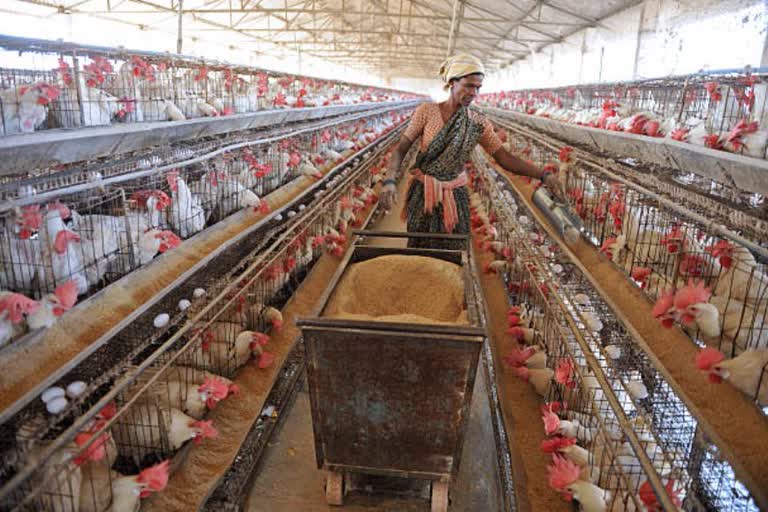Hyderabad: Domestic Poultry Farming Community circles are worried by US pressure on India to reduce import tariffs on chicken legs. President Donald Trump had been reportedly referring to the import tariff on poultry being imported from India, when Prime Minister Narendra Modi visited the US recently.
Trump is using all of this as a tool to benefit in the upcoming US election. Industry sources worry that if import tariffs are reduced, it can pose a great threat to the Indian Poultry Industry.
The Indian Poultry Farmers are requesting and trying to bring pressure on the Indian Government, not to give in to Trump’s strategies.
The Indian poultry industry is recovering due to a significant increase in the consumption of chicken meat, at a global level. Information about large import of chicken legs from the US at this stage is causing confusion in domestic poultry communities. If that happens, the price of poultry meat significantly gets reduced and the domestic industry is threatened to a large extent.
Currently, India imposes 100% tax on poultry imports. The US wants to reduce it to 30%. In the past, the poultry industry has suffered due to the falling prices of meat and poultry. The recent increase in meat consumption seemed to give the poultry farmers, maize and soybean farmers a reason to be hopeful on their business outcomes.
Industry sources have warned that opening the doors to foreign products at this stage might be dangerous.
There are interesting reasons behind the importation of chicken legs from the US. Public in US prefer eating the Pie (Breast) of the chicken which is low in fat, and do not prefer eating chicken legs. The pie (breast) portion of the chicken is preferred over food. The amount of fat in the chicken legs is presumed to be high than that in the breast. Hence, this choice of the breast over leg!
Also, Americans use knives and forks when they eat food. Another reason for their reluctance is the fact that it is embarrassing to plunge into and eat the chicken leg on a table. So there is very less demand for chicken legs all over America. They are just stored in refrigeration rooms.
America has previously exported chicken legs to the Third World countries, the European Union and China. Eventually, the markets of the respective countries became self-sufficient in meat products. US attention has now shifted to India due to the growing commercial rivalry between the US and China, and the sharp increase in poultry production in China.
Read more:US-Iran tensions hit Indian basmati exports
The Indian market, which has a population of over 135 crores, is a high hope for America. Indians prefer to chicken thighs (chicken legs or drumsticks), which is also providing a viable market to the US poultry industry to dump all their produce onto us. Poultry meat is the cheapest in America. So there is no doubt that these products will be able to overwhelm Indian markets at very low prices.
The poultry sector accounts for a trillion rupees of the annual Gross Domestic Product of India. About 9,000 crores of eggs are produced annually in the country. India (after China) is the second largest producer of eggs in the world.
Approximately 400 million broiler chickens are produced annually across the country. India ranks third in the poultry industry, the first and second being US and China. The World Health Organization (WHO) recommends the use of eggs as a nutritional supplement for poor children. India's per capita consumption of eggs is 68 eggs per year against the recommended 180 eggs and 3.5 kg as against 11 kg chicken which was suggested by the National Nutrition Organization (NIN).
There are plenty of options that the industry needs to expand to match to this extent. Around 40 lakhs are employed in the domestic poultry industry, amongst which about 20 million people are employed by the maize and soybean farmers itself. In India, poultry feed is mainly constituted by corn and soybean. Farmers plant these crops that focus on the feed requirement of the poultry industry.
About half of the harvest of these crops is consumed by poultry industry. If the Indian poultry industry is hit, the plight of these farmers is in danger as such is poultry farming.
Eating habits of citizens are changing rapidly in India. The youth is getting accustomed to ‘fast food’ such as pizzas and burgers. Eating non-veg in hotels has also increased. In this sense, the demand for chickens from the US is expected to be good. Indians, however, prefer fresh food. Though western cultures are expanding - the vast majority Indians are still consuming fresh vegetables and meat.
For this reason, vegetable markets and chicken centres were established in every colony of towns and cities of India. So we have to look at the demand for chilled chickens in India.
Industry representatives are shouting out to the central government that reducing import tariffs on poultry meat would put millions of domestic workers at risk. They state that the closure of poultry farms and processing units would become inevitable. There are expectations that this will hurt the rural economy.
For decades the Indian poultry industry has grown without any support of the government. In such a case, if the bilateral agreement with the US to reduce tariffs is agreed upon, the industry will definitely decline at a rapid rate. The industry will suffer taking along the nation’s economy plunge into darkness, in the years to come!!
(Neeli Venugopal Rao)
